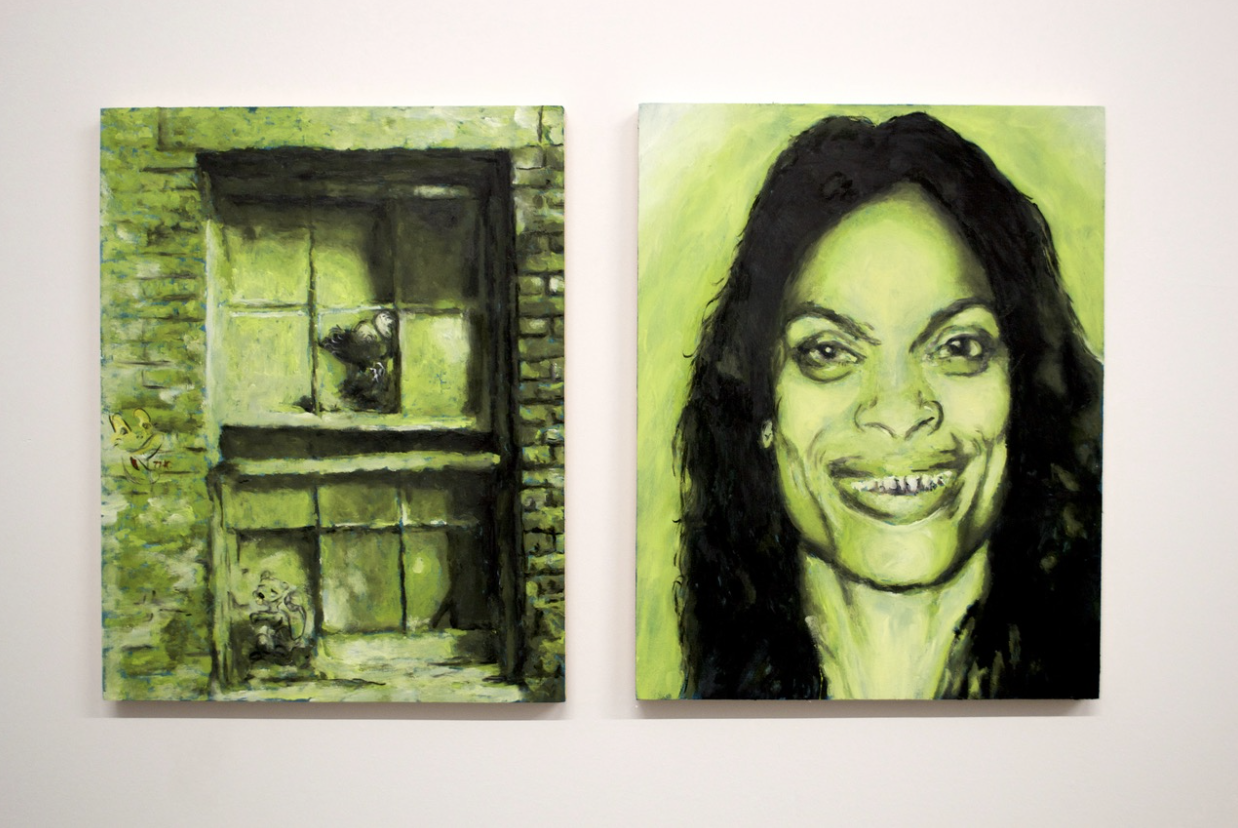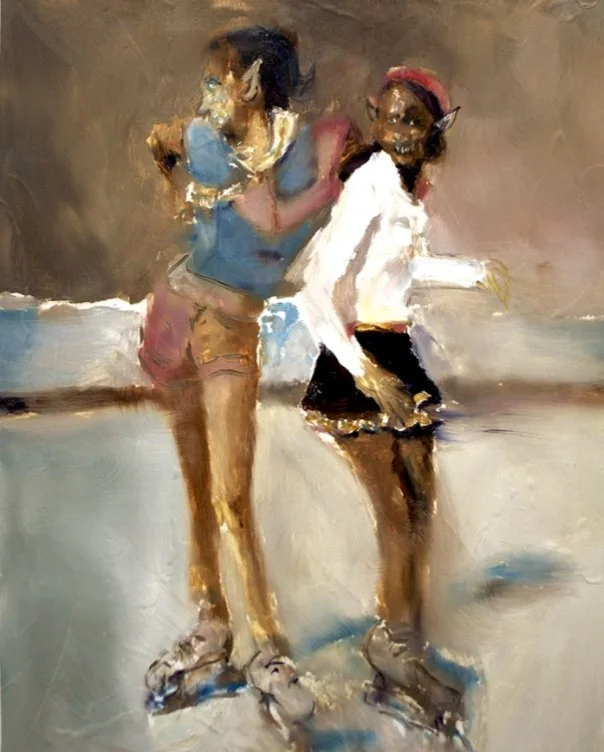In Conversation: Taína Cruz
Taína Cruz is an archivist, artist and researcher based in New York. Writer and curator Charlotte Youkilis spoke with Cruz about her image-making practice, browser-based works, and spirituality.
Mind Map 2023: Wake up Call, 2023. Courtesy of the artist.
I’m from the Bronx, 2023. Courtesy of the artist.
Charlotte Youkilis for Speciwomen: How would you describe your image-making process, and how did you originally fall into this?
Taína Cruz: I collect a lot of archival images, sourcing pop culture and Tumblr references. I get really deep into these random images I find online, going into the archives of whatever databases are out there and generating or pulling images together. Ultimately, the process happens in my studio. I am sitting there for hours and I have this idea that I really want to keep delving forward into. In the studio space I can work with multiple materials and piece together whatever language best fits the practice. I would say the process of creating the image is very intuitive – I try to demystify what I am talking about, but it really is whatever strong emotion I feel at that moment.
CY: Your work tends to feature otherworldly and allegorical elements – chimerical beings, creatures with an almost dreamlike quality. I am thinking about Stay a little longer and I’ll eat you whole. To me these evoke mythology and spirituality, and there is an element of horror. Where did these concepts originate?
TC: I take a lot of reference from African American and Caribbean folklore – there are monsters, spirit guides, elves and fairies talking to you within these stories and I’ve always been drawn to them, both from listening to them growing up and through my own research. Besides that, I have a strong love for horror movies. Growing up in New York, being exposed to the punk-goth scene, that really influenced my idea to delve into the deep, dark horror and underbelly of the world. In the city, I was able to go further into the niche of artistic and gothic series of work. That’s the beginning of the influence, but over time I really have been relying on these monsters and fairies and elves to communicate what I want to say.
CY: You sometimes incorporate your own heritage and ancestry into these projects, which feels very intimate. How do you confront the personal elements of this process? Have you faced any difficulties encountering and utilizing sacred or spiritual objects and ideologies within your practice?
TC: I mean, absolutely. That ties really well into the horror trope, too. In New York, I was exposed to both of my cultures simultaneously. My mom is African American from the deep South, and my dad is born and raised in New York as a Puerto Rican, so Nuyorican almost. I had these easily accessible areas where I could go one street over to the libraries and see representations of myself. Then the next block over would be a theater production of whatever was culturally significant at that moment.
A large part of my work is about spirituality and religion in a way that surfaces the horror aspect of spirituality. I am working through these ideas of the darkness of spirituality. Having a parent so in love with prayer and the idea of community within religion, I am trying to enhance the darkness or the shadow work within meditation and spirituality. Art making for me has always been healing. Delving into the cultural significance of my work, I have to take it in an almost humorous, ironic way. I am trying to answer the difficulty part because when I am referencing something that’s so involved in generational trauma, I don’t want to play it off to the viewer as something that already happened. It’s more of me trying to bring in the story that this still happens, and will forever happen, and that my work is going to remain in that space.
CY: Has your own relationship to spirituality and religion shifted as you make art?
TC: I have come to understand my own ritual and practices, which I don’t share with anyone. I built such a spiritual practice with my studio because I never really had a space to myself. I am a person who likes to work independently and having that studio space allowed me to develop a communication with the walls around me. Whatever I was making, whatever ritual or exercise I did before starting a painting or a sculpture, that was building my own spiritual practice. It took me being separated from where I grew up to really admire and explore the topics that I am experimenting with now. I needed space in order to observe, appreciate and respect what was taught to me.
CY: I understand that theory and research are significant to your artistic process. I am curious about how reading and writing affect your visual work.
TC: I would say my relationship to writing is not the best. I spent a lot of my time in academic spaces building my artistic or painterly and sculptural voice. I gave the visuals much more time than the writing, so my relationship to writing is very strained. When I do use writing, it’s necessary. I am not purposely searching out to include text or words within my work. The reading element came from getting to college and developing my own English from what I found most interesting.
CY: Relatedly, you use words within and alongside your drawing and mixed media work. I would love to hear your thoughts on the interplay between the verbal and the visual. Specifically with Solar Time Ritual, where you place text within the virtual landscape.
TC: Solar Time Ritual is definitely a text-based art piece. A lot of my pieces tend to have a play on spirituality and meditation – how to reach nirvana or ecstasy through breathing exercises, really finding the humorous aspect behind all of that. With Solar Time Ritual, the question was whether I wanted to include a voice to guide the viewers through picking up the artifacts. I had another video of a CGI robot Halle Berry guiding people through breathing exercises to reach ecstasy, so there it was necessary for her to be speaking to the viewers, whereas Solar Time Ritual works at your own pace. You can find the objects whenever you want to, you can explore the spaces at your own time and leisure. Sometimes voice activates a different sense of being when you’re in a meditative state. Solar Time Ritual was also my first time getting paid to hire a team of people – a coder, some friends from college doing 3D modeling work – I was orchestrating this project that I had in mind, and it was a wonderful feeling to have the resources to build something out of thin air. I definitely wanted to play on spirituality and gaming as leisure and relaxation. For this specific project it was necessary for it to be video mixed with the interactive element.
CY: I keep thinking about Solar Time Ritual and its structure as a browser-based experience that explores ancient artifacts. I am curious about your choice to use technology and digital materials to look at the past – can you tell me more about that?
TC: That’s a beautiful question because it is intentional. I love technology, I love the internet. I grew up with the internet as this voice of community and opinions, so it’s always necessary for me to tackle new age cybernetics in combination with ancestral wisdom and ideas. Combining those two creates solutions for the future. It also creates an inner peace for myself. I really like to play on the past, present, and future in my work, and technology is the future regardless of what anyone says. The artifacts are my way of confirming that I will have a place in the future. I can build upon this artifact base of the internet – the internet has such a strong archive, there are so many sites that archive information, newspapers, videos. I’m having fun with the idea of creating my own objects and allowing the viewers to figure out whether they’re the right objects to save.
CY: Would you say that varying geographies and spaces influence the work you make — from being born and raised in New York City to living between Baltimore and Chicago?
TC: It definitely does. I take in the environment and the ground that I am sitting on so much. I can see the direct influences over time on my work. Baltimore was art school – I was far away from New York but close to family from Washington, DC, so I had this great balance. There was comfort but also a sense of experimentation. I studied sculpture in undergrad – I was playing around with metal, wood, computers, technology, finding how to build objects. It was a chance for me to experiment. In Chicago, I have been working primarily with painting. I had a painting practice growing up that disappeared while I was doing my experimentation in undergrad, so the last three years in Chicago I have built upon what I grew up learning about painting. It was often honing in on technical skills, sitting still for seven hours straight fixing and correcting a painting, the precise coloring and material techniques. Whereas in Baltimore, I was within the experimentation phase, the mad scientist connecting motors and wires together to see if something will move. Being in those different spaces and working with the different mediums created an entirely new body of work. I see the influence of New York as central to my pieces now. I am definitely honing back on memory and remembering what I learned in New York for those eighteen years. That’s why it’s been so important to separate myself from New York City.
CY: What are you most excited by at the moment, and how do you see that influencing your upcoming projects?
TC: I am going to graduate school in the fall for painting, so throughout the past month or so I’ve been honing my portfolio. Now that I’ve gotten in, I’m doing some more experimentation and playing around. I was asked to do a solo show in Berlin at Kraupa Tuskany Zeidler in September. It’s my first time showing outside of the states. I’ve had two solo shows, one in New York City and one in Puerto Rico. For Berlin, I’m relying on what I know the city to be, very much nitty-gritty, sort of recalling the teenage self and conceptions of Berlin. So I’m really excited to flesh through the nightclub, underground culture of Berlin, but I’m excited to have this happen before graduate school starts because the next two years I will really break down what I’ve learned and created. I will use that time to start experimenting and going wild and crazy, seeing what I can get away with, almost. The Berlin show will be a nice leeway to a closing chapter of showing with galleries and the art fairs.
Ice Princesses of Harlem “11, 2023. Courtesy of the artist.
Solar Time Ritual (Screenshot at 00:07:26), 2022. Courtesy of the artist.
Stay a Little Longer, 2023. Courtesy of the artist.




